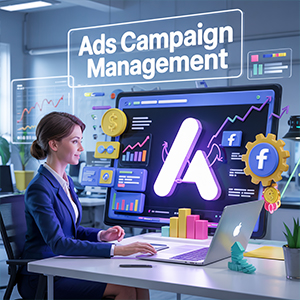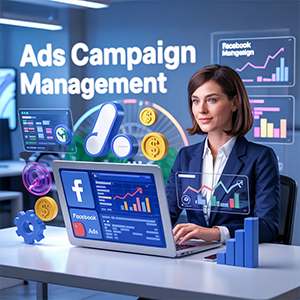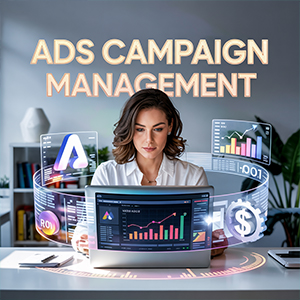



Ads Campaign Management: A Comprehensive Guide
1. Introduction to Ads Campaign Management
Advertising campaign management is the structured process of planning, executing, monitoring, and optimizing paid advertising campaigns across various digital platforms. It encompasses everything from identifying business goals to selecting the right audience, creatives, bidding strategies, and measuring performance metrics to achieve maximum return on investment (ROI).
In the ever-evolving landscape of digital marketing, businesses cannot afford to run uncoordinated or poorly measured ad campaigns. Successful campaign management ensures the brand message reaches the right people, at the right time, using the right medium, and at the right cost.
2. Why Ads Campaign Management Matters
2.1. Data-Driven Decisions
Ads campaign management is rooted in analytics and data. It allows marketers to understand what’s working and what’s not. With real-time performance tracking, businesses can make informed decisions.
2.2. Budget Efficiency
Proper campaign management ensures that advertising budgets are spent wisely. It helps avoid wasted ad spend and reallocates funds to top-performing campaigns or ads.
2.3. Audience Targeting
Campaigns can be designed to target specific demographics, behaviors, interests, and even customer intent. This increases relevance and engagement.
2.4. Continuous Improvement
By managing ad campaigns effectively, you can continuously test, learn, and improve. A/B testing, creative rotation, and performance tracking contribute to better results over time.
3. Types of Ads Campaigns
3.1. Search Ads
- Appear on search engine result pages (SERPs).
- Useful for intent-based targeting.
- Platforms: Google Ads, Bing Ads.
3.2. Display Ads
- Appear on websites within the ad network.
- Used for brand awareness and remarketing.
- Platforms: Google Display Network, AdRoll.
3.3. Social Media Ads
- Appear on social media platforms like Facebook, Instagram, LinkedIn, and Twitter.
- Useful for demographic and interest-based targeting.
3.4. Video Ads
- Delivered via YouTube, Facebook, TikTok, and other video platforms.
- Highly engaging format.
3.5. Shopping Ads
- Used for promoting e-commerce products.
- Appear on search engines and social media.
- Platforms: Google Shopping, Meta Advantage+ Catalog Ads.
3.6. Native Ads
- Blended into the content of the site.
- Less intrusive and often has higher engagement.
3.7. Programmatic Ads
- Automated buying of digital ads using algorithms and real-time bidding (RTB).
- Platforms: DSPs (Demand Side Platforms), Google DV360.
4. The Campaign Management Lifecycle
4.1. Goal Setting
- Define clear goals (brand awareness, lead generation, conversions, app installs).
- Align goals with KPIs (click-through rate, cost per click, ROAS).
4.2. Audience Research
- Use analytics, surveys, and CRM data.
- Create buyer personas.
4.3. Channel Selection
- Based on where your audience spends time.
- Budget-friendly and goal-oriented.
4.4. Budget Planning
- Decide daily/monthly spend.
- Allocate based on audience size, bid competition, and goal difficulty.
4.5. Creative Strategy
- Copywriting, visuals, videos.
- A/B testing of different formats.
4.6. Campaign Setup
- Structure campaigns (ad groups, targeting, bidding, scheduling).
- Upload creatives and configure settings.
4.7. Launch
- Monitor launch metrics closely (first 24–72 hours).
- Check for technical issues or ad disapprovals.
4.8. Monitoring & Optimization
- Daily/weekly performance review.
- Adjust bids, creatives, and audiences.
4.9. Reporting
- Weekly, monthly, and end-of-campaign reporting.
- Use dashboards and visualization tools.
5. Targeting Techniques
5.1. Demographic Targeting
- Age, gender, income, education, marital status.
5.2. Geographic Targeting
- Country, state, city, radius, or zip code.
5.3. Behavioral Targeting
- Past behaviors like website visits, page views, shopping behavior.
5.4. Interest-Based Targeting
- Based on likes, follows, and content consumed.
5.5. Lookalike & Similar Audiences
- Find new users who resemble existing customers.
5.6. Retargeting
- Engage users who interacted with your brand but didn’t convert.
6. Budgeting and Bidding Strategies
6.1. Daily vs. Lifetime Budget
- Daily budgets give more flexibility.
- Lifetime budget ensures pacing over the campaign duration.
6.2. Manual Bidding
- Set your own bid amount.
6.3. Automated Bidding
- Let platforms optimize for conversions or impressions.
6.4. ROAS Targeting
- Focus on a specific return on ad spend.
6.5. Bid Cap & Cost Cap
- Control how much you’re willing to pay per conversion or impression.
7. Creative Strategy and Ad Copywriting
7.1. Visuals
- Use high-quality images, videos, carousels, or interactive formats.
7.2. Headlines
- Grab attention in 2–3 seconds.
7.3. Call-to-Action (CTA)
- Must be clear and compelling (Shop Now, Learn More, Get a Quote).
7.4. A/B Testing Creatives
- Test variations to find what works best.
7.5. Ad Format Selection
- Choose the right format for each platform and goal.
8. Analytics & KPIs
8.1. Key Metrics
- Impressions
- Clicks
- Click-Through Rate (CTR)
- Cost Per Click (CPC)
- Conversion Rate
- Cost Per Acquisition (CPA)
- Return on Ad Spend (ROAS)
8.2. Attribution Models
- Last-click, first-click, linear, time-decay.
8.3. Conversion Tracking
- Use tags and pixels (Meta Pixel, Google Tag Manager).
9. Optimization Techniques
9.1. Creative Rotation
- Avoid ad fatigue by rotating visuals and copy.
9.2. Audience Refinement
- Remove underperforming segments.
9.3. Bid Adjustments
- Increase bids for top-performing ads or placements.
9.4. Campaign Budget Reallocation
- Shift spend from poor performers to top performers.
9.5. Landing Page Optimization
- Speed, layout, copy, CTA should be aligned with ad content.
10. Cross-Platform Campaign Management
10.1. Unified Strategy
- Ensure message and branding consistency across platforms.
10.2. Attribution Tracking
- Avoid double-counting conversions.
10.3. Budget Distribution
- Allocate budget based on platform performance.
10.4. Automation Tools
- Use tools like HubSpot, Sprinklr, or AdEspresso.
11. Tools for Campaign Management
- Google Ads Manager
- Meta Business Suite
- LinkedIn Campaign Manager
- Google Analytics
- SEMrush / Ahrefs
- Hotjar / Crazy Egg
- Klaviyo (for email retargeting)
- Zapier (for automation)
- Data Studio / Looker / Power BI
12. Reporting & Insights
12.1. Weekly Reports
- Quick performance summaries and budget updates.
12.2. Monthly Reviews
- Trends, challenges, wins, and action items.
12.3. Quarterly Deep-Dives
- Strategic insights and forecasting.
13. Common Mistakes to Avoid
- Poor targeting.
- Lack of conversion tracking.
- Ignoring ad frequency and fatigue.
- Not testing different creatives.
- Not optimizing based on performance data.
- Misaligned landing pages.
14. Emerging Trends in Ads Management
14.1. AI & Machine Learning
- Predictive analytics, smart bidding, AI-generated content.
14.2. Privacy Changes
- First-party data focus due to cookie depreciation.
14.3. Automation
- Automated workflows for reporting, campaign management.
14.4. Omnichannel Strategies
- Coordinated campaigns across email, SMS, search, and social.
15. Roles and Responsibilities in Campaign Management
15.1. Digital Marketing Manager
- Oversees strategy, coordinates team, and client relationships.
15.2. Paid Media Specialist
- Manages ad platforms, targeting, bidding, and optimization.
15.3. Creative Designer
- Designs static and dynamic creatives.
15.4. Copywriter
- Crafts headlines, body copy, and CTAs.
15.5. Data Analyst
- Monitors performance, builds reports, and provides insights.
16. Case Study: Successful Campaign Execution
Client: E-commerce Brand
Objective: Increase sales by 30% in Q4
Platform: Facebook Ads + Google Search
Strategy:
- Multi-step funnel
- Custom audiences and lookalikes
- Dynamic product ads
- Manual CPC optimization
Results:
- 42% revenue growth
- ROAS of 6.2x
- CTR increased by 27%
17. Conclusion
Ads campaign management is a cornerstone of modern digital marketing success. It blends data, creativity, and strategy to drive measurable business growth. With the right tools, tactics, and continuous optimization, campaign managers can significantly improve performance and ROI.
